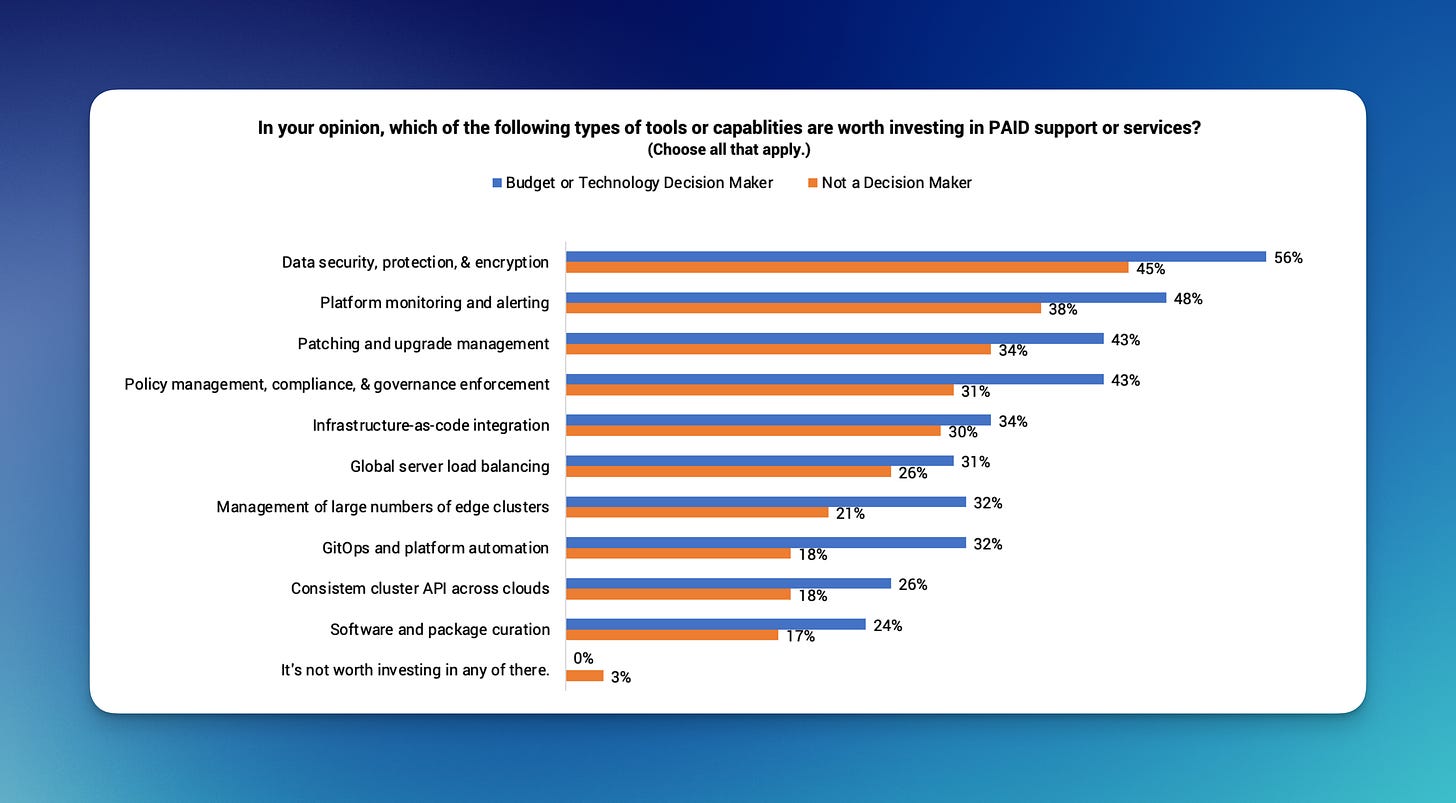Coté
Teaching to the Test. Why It Security Audits Aren’t Making Stuff Safer - Bullshit Work in enterprise security. // Plus, why not start with basics before going advanced: ‘The world would be better off if organizations stopped wasting so much time and money on these vendor solutions and instead stuck to much more basic solutions. Perhaps if we could just start with “have we patched all the critical CVEs in our organization” and “did we remove the shared username and password from the cloud database with millions of call records”, then perhaps AFTER all the actual work is done we can have some fun and inject dangerous software into the most critical parts of our employees devices.'
The Six Five: Advancing DevOps: Infrastructure as Code, Platform Engineering and Gen AI - “we see in our latest research that 24% of organizations are looking to release code on an hourly basis, yet only 8% are able to do so."
Why Is Demand Marketing An Obstacle To Its Own Success? - ‘Too many marketing subfunctions (demand/ABM, field marketing, customer marketing, digital, and events) create strategies unique to their function, independent from the others. Marketers often say that they have a “unified” plan, but it’s more like a PowerPoint deck with “chapters” for each team’s individual plan. This approach prevents marketers from orchestrating programs to reduce overlap and waste, and what’s worse, it has a direct, negative impact on buyers and customers.'
The Prompt Warrior - Posts on prompts for all sorts of things.
fabric/patterns - Whole bunch of prompts on a range of topics, even D&D!
Why CSV is still king - We have a running joke on the podcast that every (enterprise) app needs CSV export. It’s only 10% a joke.
Epic corporate jargon alternatives - Poetic alternatives to business bullshit jargon.
2025 Demand and ABM Budget Planning Guide: Do Better With Less - Enterprise software marketing budgets mostly flat, if not less: ”On the surface, it may appear as if most budgets are increasing, as 82% of global B2B marketing decision-makers report their budgets being increased by 1% or more. But once you adjust for inflation, it’s the same old story, as only 35% of organizations will see a real increase in budgets (with 31% of the 35% saying that the increases would be in the 5–10% range and 4% saying that their budgets would increase by 10% or more).”
What people buy for Kubernetes
Where the Kubernetes spend is
Here’s a presentation recording going over our recent Kubernetes survey. I’ve mentioned it several times here, but there’s some new charts (like the above) and commentary in this talk I did with Rita and Danielle. Check out it for free in LinkedIn.
Wastebook
1 cup toilet chemical solution, three cups water. Add every three days or so.
This year it’s gonna be beef rib buffet at SDT club.
”Seems like something that Netflix would try to turn into a series and then cancel it three seasons in.” Here.
Its really hard to do “everything” of anything.
“There are probably plenty of web-based and app based dice rollers already, but as they say, there are also plenty of love songs and people still continue to write them!” Here.
Relative to your interests
The beauty of concrete - "ornament survives in the mass-market housebuilder market because the people buying new-build homes at this price point are less likely to be influenced by elite fashions than are the committees that commission government buildings or corporate headquarters. The explanation, in other words, is a matter of what people demand, not of what the industry is capable of supplying: ornament survives in the housing of the less affluent because they still want it.”
A note on the EU AI Act - “The requirements look entirely reasonable considering these products are being positioned to become central to modern software – they’re effectively positioned to become the entirety of modern computing.” // And, this pairs well with this claim: “Sales workflows will fundamentally change. With AI, sales teams will no longer need to spend endless hours researching new leads or prepping for calls – AI will be able to do it in seconds. Reps won’t have to suss out the readiness of potential customers because AI will have automatically compiled a ranked list of primed buyers, and will keep it constantly updated. Need personalized marketing collateral for a deal? Your AI wingman will produce whatever assets you need and feed you live tips while you’re on a call to help you close.”
Debugging Tech Journalism - Covering a handful of “tech companies,” focusing on the problems.
The future of healthcare: Why enterprises must embrace AI innovation - Some use cases and applications for AI stuff in healthcare.
From Burnout to Balance: AI-Enhanced Work Models for the Future - ”Nearly half (47%) of employees using AI say they have no idea how to achieve the productivity gains their employers expect”
Words to Avoid and Replace - Some good Business Bullshit word translations and optimistic-ization.
Why Return-to-Office Mandates Aren’t Worth the Risks - From Gartner! But, not much of a slam dunk either way as this promotional post doesn’t put out many numbers pro or con. “The benefits prove to be modest at best, and amid a rising well-being crisis, waning trust between employees and their employers, and a competitive talent market, it’s high time to ask whether the benefits of RTO mandates are worth the risks.” And: “High-performing employees report a 16% lower intent to stay in the face of on-site work requirements.” // There’s a lead-gen’ed PDF I’ll have to look at.
The CrowdStrike Outage and Market-Driven Brittleness - ”Last week’s update wouldn’t have been a major failure if CrowdStrike had rolled out this change incrementally: first 1 percent of their users, then 10 percent, then everyone. But that’s much more expensive, because it requires a commitment of engineer time for monitoring, debugging, and iterating. And can take months to do correctly for complex and mission-critical software. An executive today will look at the market incentives and correctly conclude that it’s better for them to take the chance than to “waste” the time and money.”
Don’t miss these VMware Tanzu sessions at Explore 2024 - What’s important to notice here are the number of companies relying on Cloud Foundry (the Tanzu Platform for Cloud Foundry, or tPCF as I think of it) to run their business. More so, that most have been doing so for years. Our PaaS just works. You don’t need to figure out how it works and build a platform out of it, it’s already a platform, a proven one. I’m looking forward to all the real world proof points, cases, and advice in these talks.
Is Cloud Native a Vibe? Power Users Weigh In - “Cloud native is more than just a way of building apps; it’s a lifestyle and a state of mind. A company that has accepted this fact is working along agile principles with single teams having responsibility for the full lifecycle of their products, which means they own the product. Often, companies like this have flat hierarchies and value the individual knowledge of every employee to drive the products forward. Surely this is only possible with technology that supports these modern operating models, and it’s much more than just the technology.” -Jürgen Sußner, enterprise architect at DATEV
Cloud Foundry in Action: Real Customers Stories from Cloud Foundry Day - ”We run a tremendous number of applications on top of Cloud Foundry. The ones that really impress me might surprise some people. It’s not just Black Friday sales but also the Amazon Prime events. When these events kick off, there’s an incredible surge in load across everything we care about, including credit card points processing, all handled by Cloud Foundry.” - Tom Brisco, JPMorgan & Chase Co.
The employment effects of a guaranteed income - “1.3–1.4 hour per week reduction in labor hours.” // Yes, and: if we buy into the premise that a lot of work is Bullshit Work, this isn’t enough, we need more like six to 8 hours of wasted time to convert to living, not sitting in inefficient meetings.
Also, check in on the past two weeks of Software Defined Talk for tech news and commentary: episode 477 and episode 478. I’ll be back on it this week.
Conferences, Events, etc.
Talks I’m giving, places I’ll be, and other plans.
This year, SpringOne is free to attend and watch online. Check out Josh’s pitch for the event. There’s an on-site conference as well at Explore if you’re interested. But, for those who can’t, now you can watch all the fun!
SpringOne/VMware Explore US, August 26–29, 2024. DevOpsDays Antwerp, 15th anniversary, speaking, September 4th-5th. SREday London 2024, speaking, September 19th to 20th. VMware Explore Barcelona, speaking(?), Nov 4th to 7th.
Discounts. SREDay London (Sep 19th to 20th) when you 20% off with the code SRE20DAY. And, if you register for SpringOne/VMware Explore before June 11th, you’ll get $400 off.
Logoff
This summer I looked around at new jobs a bit - it’s good to do that once a year to see what’s going on, make sure you’re managing your career fully and actively, catch-up with people, and figure out if you like your current job. I ended up staying at my job.
During that, I talked with some analyst firms. This gave me some ideas for a long piece I wrote on how big industry analyst firms could change their business model. Well, more like add in more Internet and “the kids” friendly methods of publishing and business generation. There’s a lot of potential for the big firms to put out more of their content for free in new channels (like YouTube, newsletters, and podcasts), introduce some mid-tier pricing, and start addressing looming problems of their customer-base changing. There’s what looks like text-book case of innovator’s dilemma at play.
But, I need to go and make sure they don’t already do all this before I say they should do it. Hah-hah-hah-hah! The Free Advice Racket!
//
I’m back from a two week vacation in Finland with family and friends. We rented an RV drove from Helsinki all the way north to Alta, Norway. Finland is huge! We only drive 4 or 5 hours a day, so it took awhile to get up there. After living in the Netherlands for over six years, seeing all of the pure nature there is almost overwhelming: hills, mountains, fjords, trees! Anyhow, it’s great. I’ll post some photos on Instagram, here’s the first batch.
As far as I can remember, it’s the first vacation I didn’t want to end. I mean, vacation is great, but with when you’re with three kids, it’s more like a “trip,” and getting back to work can be relaxing.
The beauty of concrete - “ornament survives in the mass-market housebuilder market because the people buying new-build homes at this price point are less likely to be influenced by elite fashions than are the committees that commission government buildings or corporate headquarters. The explanation, in other words, is a matter of what people demand, not of what the industry is capable of supplying: ornament survives in the housing of the less affluent because they still want it.”


